Blog
[Kyoto] Philosopher’s Path: A Tranquil Stroll through Japan’s Scenic and Historic Heart

Kyoto is home to some of Japan’s most iconic temples, shrines, and scenic walks, but one of the most serene and contemplative routes is the Philosopher’s Path, known as Tetsugaku no Michi in Japanese. Running through the northern part of Kyoto’s Higashiyama district, this two-kilometer stone path follows a peaceful canal lined with hundreds of cherry blossom trees. The path is especially famous for its breathtaking sakura in spring, making it one of Kyoto’s most beloved spots for hanami (cherry blossom viewing). But regardless of the season, the Philosopher’s Path offers a tranquil walk through history and nature, providing visitors with a chance to experience the reflective atmosphere that inspired one of Japan’s greatest philosophers, Nishida Kitaro.
Content
The Philosopher’s Path: Following Nishida Kitaro’s Footsteps

The Philosopher’s Path stretches from Ginkaku-ji Temple (Silver Pavilion) in the north to Nanzen-ji Temple in the south, tracing the course of a canal through the heart of Kyoto’s Higashiyama district. This peaceful, contemplative walk has long been associated with Nishida Kitaro, a philosophy professor at Kyoto University who walked this route daily while meditating on his philosophical ideas, blending Japanese Buddhism and Western thoughts. Nishida, who lived from 1870 to 1945, is said to have found clarity during these walks, and his daily routine gave rise to the path’s name.
Walking the Philosopher’s Path today allows visitors to experience the same peaceful surroundings that inspired Nishida. Whether you prefer to walk in solitude or with companions, the path offers an escape from the city’s hustle and bustle, inviting deep contemplation as you reflect on the beauty of nature and the history that surrounds you.
Seasonal Beauty of Philosopher’s Path: From Cherry Blossoms to Autumn Leaves
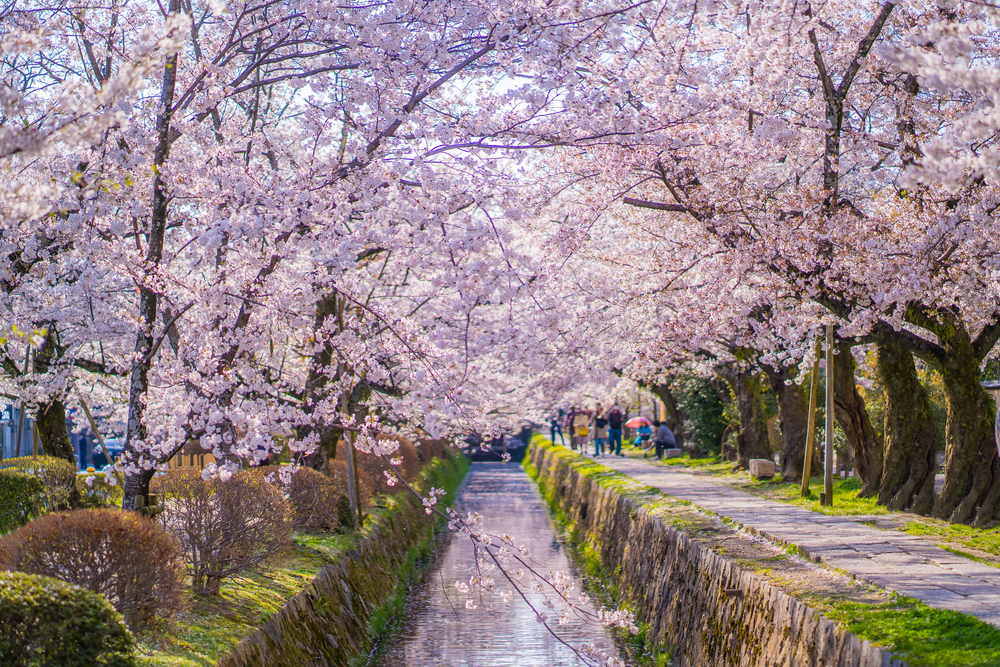
The Philosopher’s Path is renowned for its seasonal beauty. In spring, the cherry blossoms along the canal create a breathtaking sight, with hundreds of trees blooming in shades of pink and white. Visitors can enjoy a variety species of sakura, including Somei Yoshino, Oshima-zakura, Yae-zakura, and Shidare-zakura (weeping cherry trees). This annual spectacle attracts both locals and visitors, creating a lively yet tranquil atmosphere. The cherry blossoms typically peak in early April, making it one of Kyoto’s most popular hanami spots.
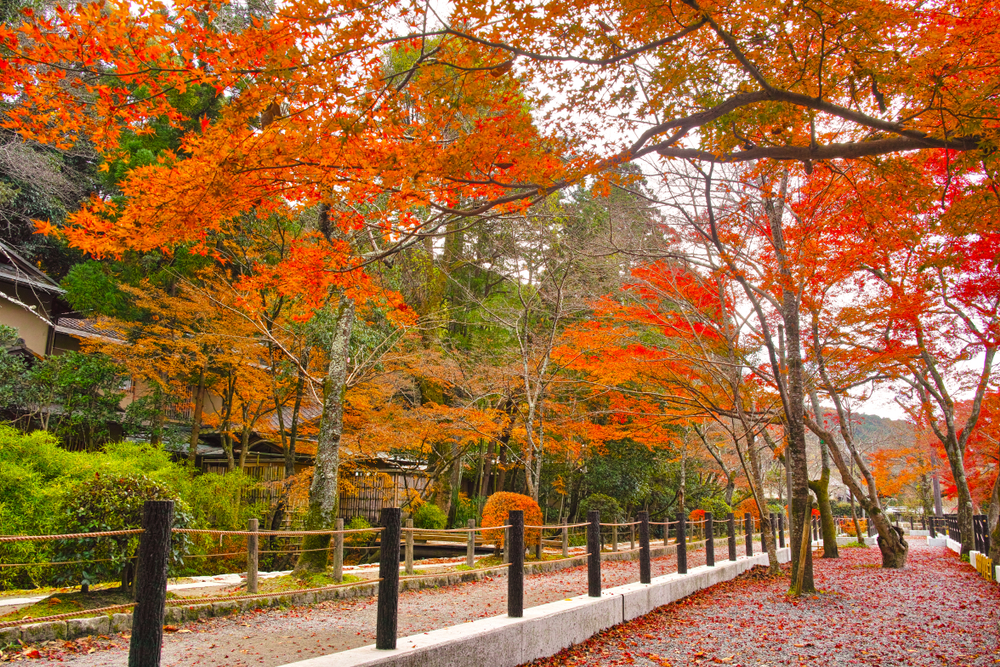
In autumn, from mid- to late-November, the path transforms into a fiery display of colors as the maple leaves turn red, orange, and gold. The contrast between the colorful leaves and the calm water of the canal creates a picturesque scene that is equally captivating. Though the cherry blossoms steal the spotlight in spring, the autumn leaves offer their own stunning beauty.
The Philosopher’s Path offers a quiet charm year-round. In summer, the dense greenery provides shade and coolness, while winter brings a serene, snowy landscape that invites contemplation. Each season has its own special appeal, making the path a wonderful place to visit at any time of the year.
Ginkaku-ji, Eikando Zenrin-ji and other Temples and Shrines Along the Philosopher’s Path
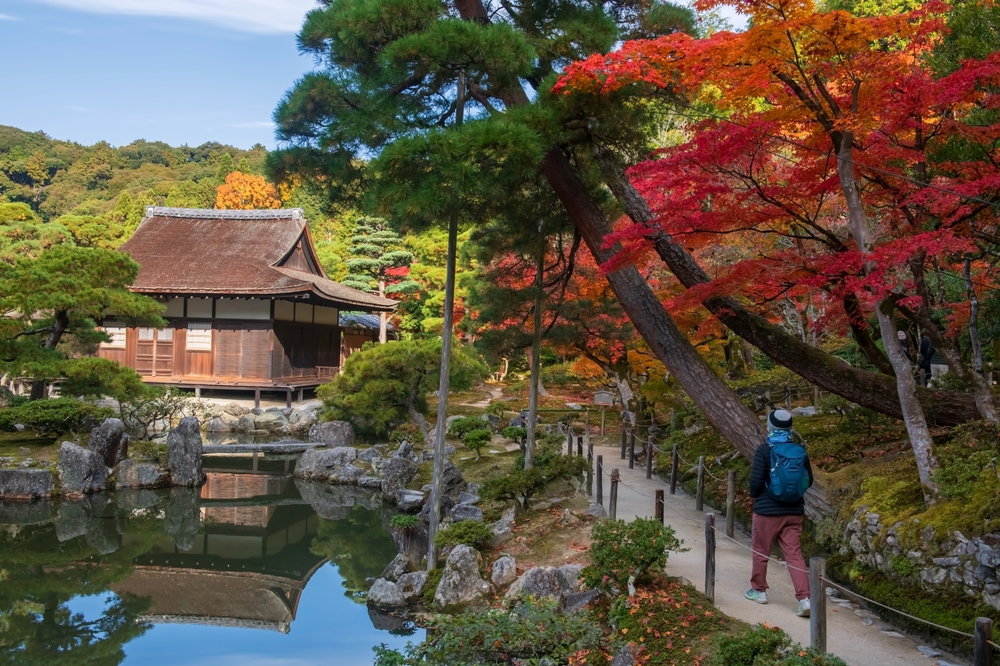
The Philosopher’s Path is lined with several noteworthy temples and shrines, offering visitors a chance to explore Kyoto’s rich history. Starting at the northern end of the path, Ginkaku-ji Temple (officially known as Higashiyama Jisho-ji) is a fitting beginning to this journey. Originally constructed as a villa for shogun Ashikaga Yoshimasa in the late 15th century, Ginkaku-ji is known for its Zen architecture, tranquil gardens, and the famous sand garden that represents Mount Fuji. This peaceful temple sets the tone for the reflective walk ahead.
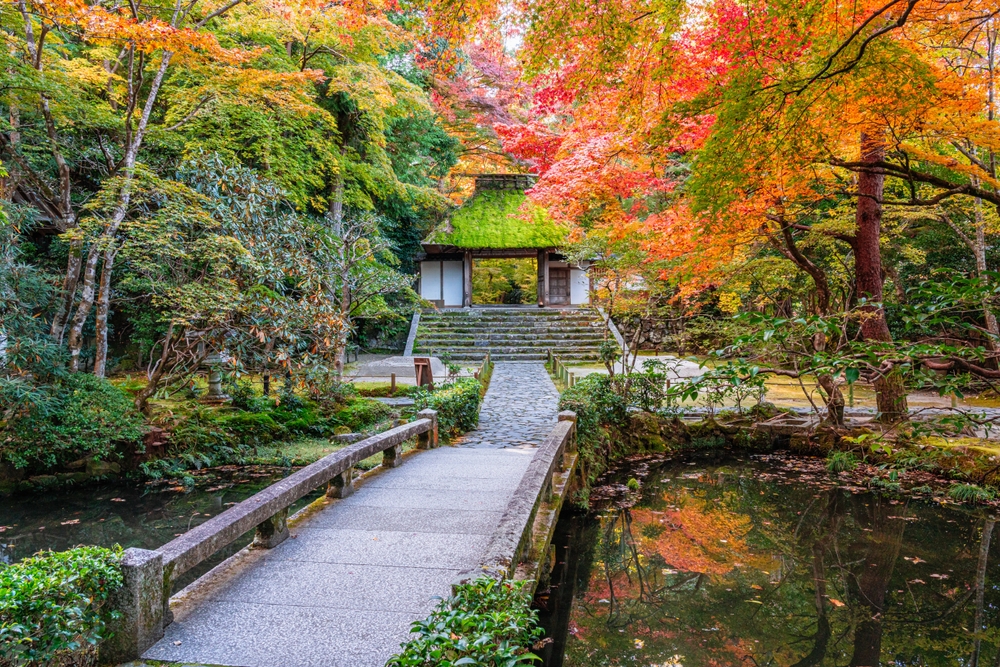
Continuing south for about five minutes, you’ll reach Honen-in Temple, a relatively lesser-known but calming spot. Although it requires a short detour off the main path, Honen-in is worth the visit. The temple’s gate, especially beautiful in autumn when framed by colorful leaves, invites moments of quiet contemplation. The surrounding gardens further enhance its tranquil atmosphere, offering a brief respite.
Further along the path for another 10 minutes, Kumano Nyakuoji Jinjya Shrine provides a small but historically rich stop. Founded in 1160 by Emperor Go-Shirakawa, the shrine is associated with cherry blossoms and has long attracted visitors, including warriors and shoguns. Its peaceful grounds provide a quiet moment to reflect before continuing south.
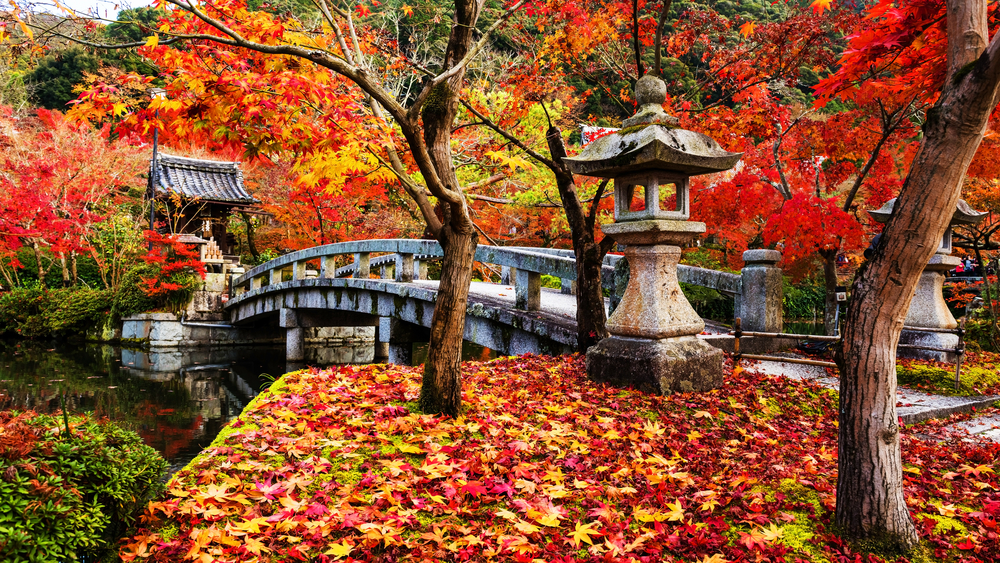
Just a 4-minute walk from Kumano Nyakuoji Jinjya, Eikan-do Zenrin-ji Temple is another short detour off the main route. This temple is particularly renowned for its autumn foliage, and the “Looking Back Amida” statue, which seems to invite followers to join him, is a notable highlight. Eikan-do Zenrin-ji also features extensive gardens that are well worth a visit, making this a peaceful spot to pause along the way.
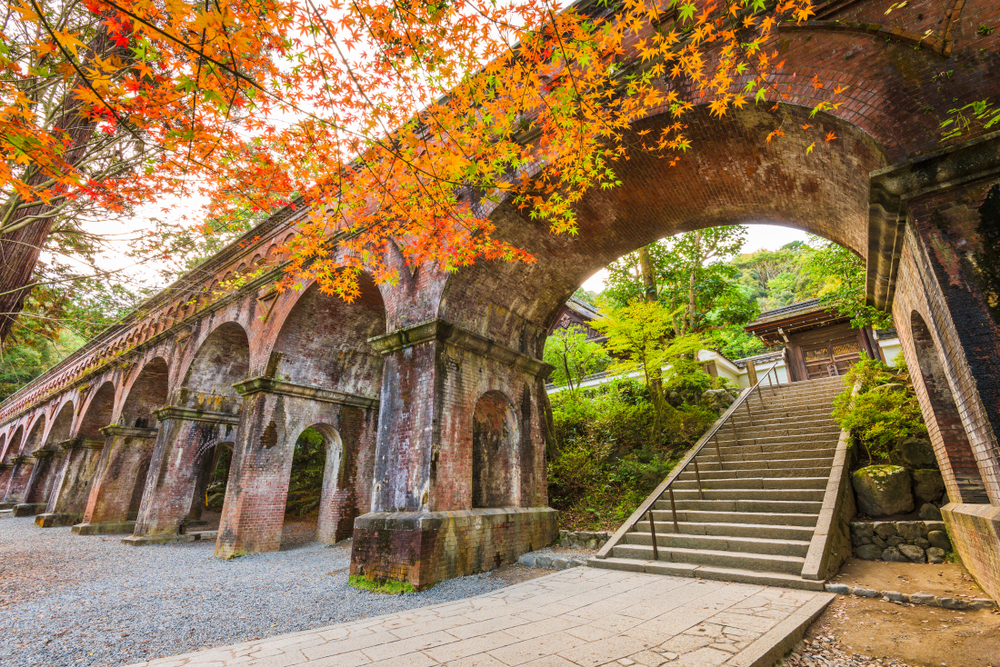
Night Views along the Philosopher’s Path
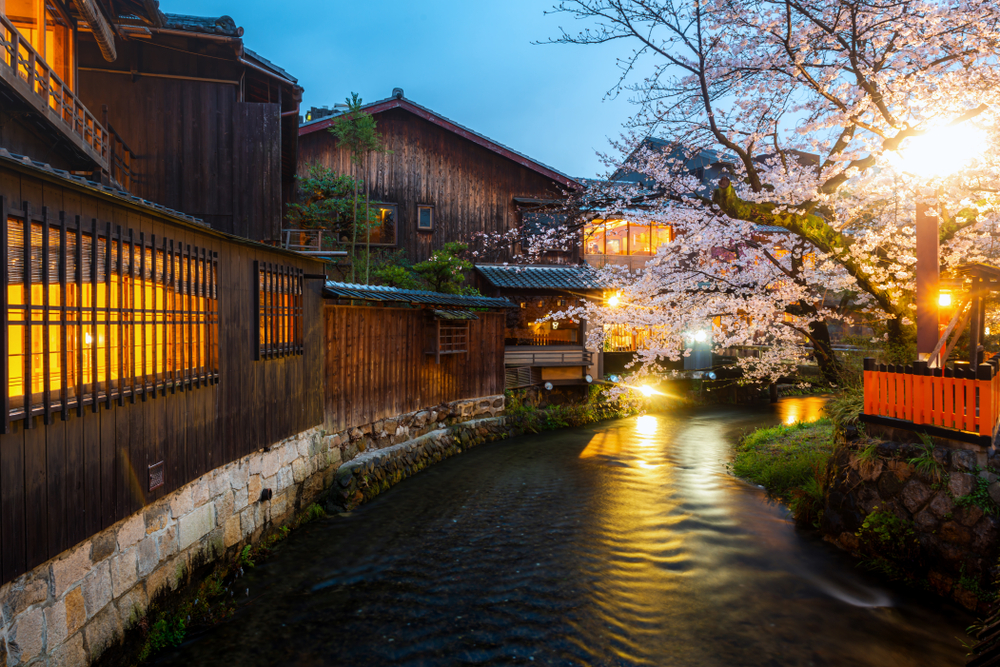
While the path is most famous for its daytime beauty, its night view is also not to be missed. After sunset, the Philosopher’s Path transforms into a peaceful and magical setting. Soft illumination highlights the canal, stone walkway, and overhanging trees, creating a romantic and contemplative atmosphere perfect for an evening stroll. The path is open 24 hours a day, so visitors can enjoy its charm at any time.
How Long Does it Take to Walk the Philosopher’s Path?
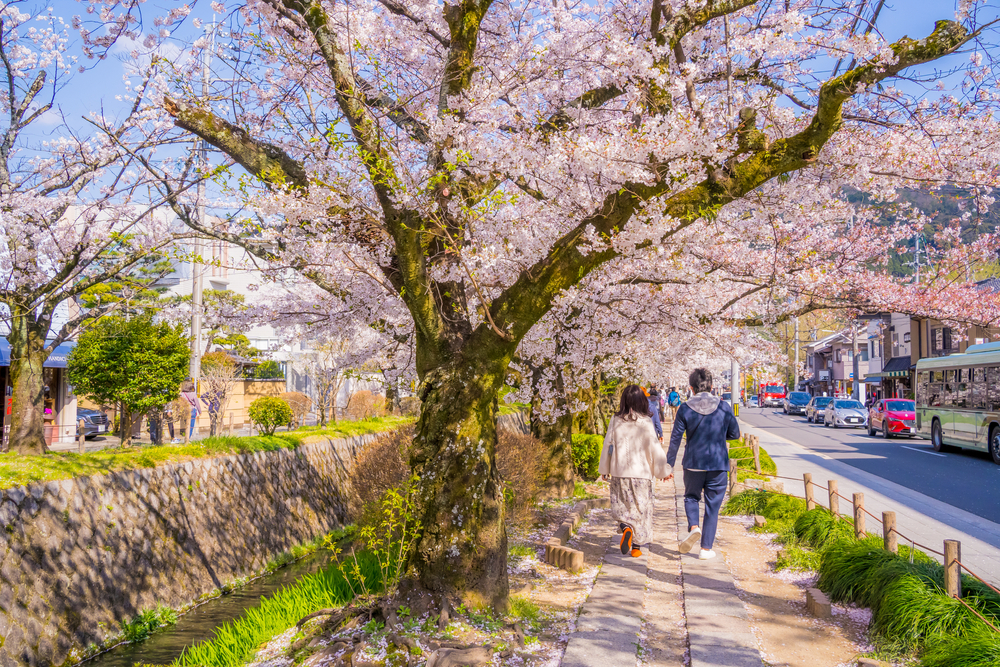
The Philosopher’s Path is best experienced slowly, allowing yourself time to pause and enjoy the scenery. While you can complete the walk usually in under an hour, most visitors prefer to take 1.5 to 2 hours, especially if they stop to explore the temples, cafes, and hidden gems along the route. For a deeper experience, plan your visit during one of the peak seasons—either the cherry blossoms in spring or the autumn foliage—but don’t hesitate to explore the path during quieter months, as each season offers something special.
Whether you’re walking alone for quiet reflection or with friends and family, the Philosopher’s Path offers a peaceful retreat in the heart of Kyoto, blending nature, history, and philosophy.
How to Get to the Philosopher’s Path from HOTEL TAVINOS Kyoto
No matter which end you choose to start your walk, the Philosopher’s Path is easily accessible from central Kyoto in approximately 30 to 40 minutes. Here’s how to get to the Philosopher’s Path from HOTEL TAVINOS Kyoto:
- North end (Ginkaku-ji, Honen-in):
Walk to the Kawaramachi-gojo Bus Stop, located right in front of the hotel. Take Kyoto City Bus Routes 5 or 7 for about 30 minutes and get off at Ginkakuji-michi Bus Stop. - South end (Nanzen-ji, Eikan-do Zenrin-ji):
Walk to the Kawaramachi-gojo Bus Stop and take Kyoto City Bus Route 5 for about 25 minutes. Get off at either Nanzen-ji Eikan-do-michi or Higashi-tennocho Bus Stop.
The path itself is just a 5 to 10-minute walk from either Ginkaku-ji or Nanzen-ji. Along the route, you’ll find numerous signs that point to the nearby attractions, as well as cafes and restaurants offering a chance to pause and enjoy some local cuisine.
The Philosopher’s Path is a must-visit for anyone seeking peace and reflection in Kyoto. Whether you’re drawn to the beauty of the cherry blossoms, the vibrant autumn foliage, or the quiet charm of the temples, the path offers an immersive experience that will leave you with lasting memories. Take a walk along the canal, discover the hidden gems of the surrounding temples, and follow in the footsteps of Nishida Kitaro for an unforgettable Kyoto experience.
Philosopher’s Path
Address: Sakyo-ku, Kyoto-shi, Kyoto
Hours: open all year round (free access)
*Temples and shrines along the way may have their own opening hours and entrance fees
Writer
Lisa Wallin
A curious sojourner, Lisa Wallin has lived in Japan for about 15 years, along with 7 other countries. She has an insatiable appetite for local narratives, with a focus on regional culture, crafts and food. When not chasing stories, she enjoys coffee, visiting shrines, and exploring the country both with and without her dogs.
